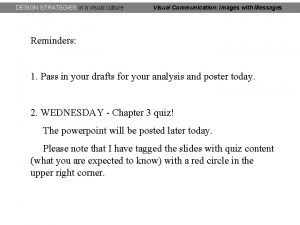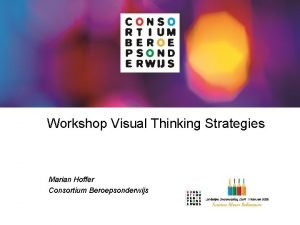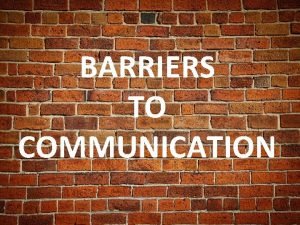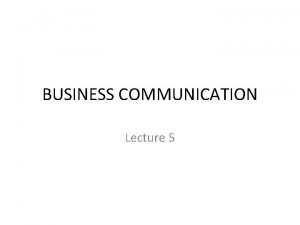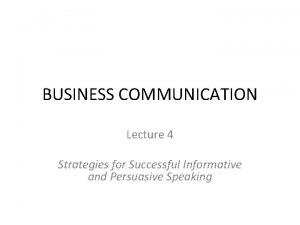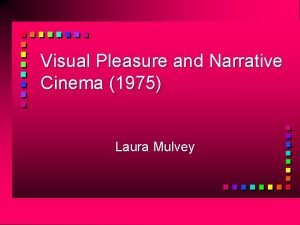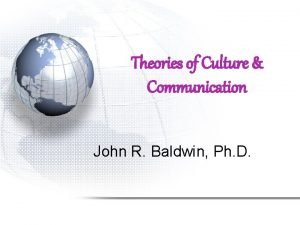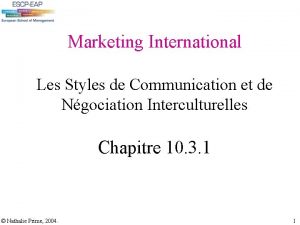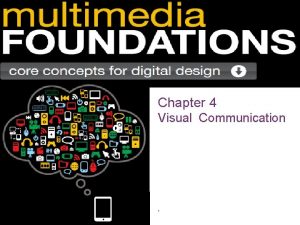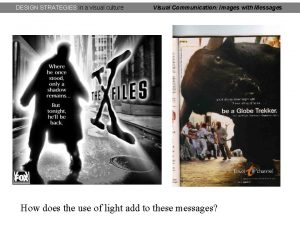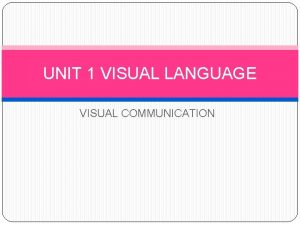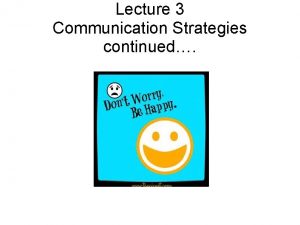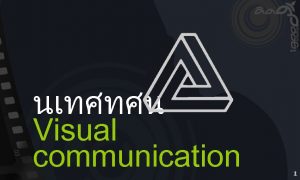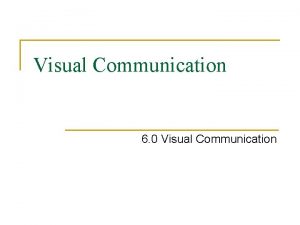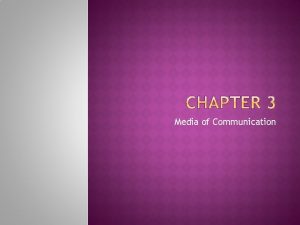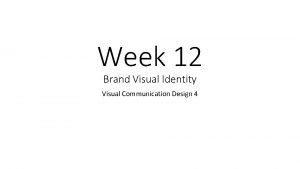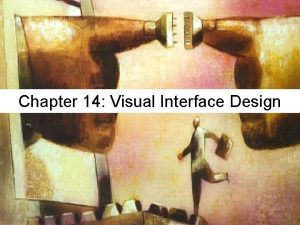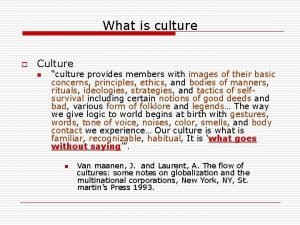DESIGN STRATEGIES in a visual culture Visual Communication





































- Slides: 37

DESIGN STRATEGIES in a visual culture Visual Communication: Images with Messages Why study this subject? To become a thoughtful, effective communicator. Every job has some aspect in which communication skills are used. Many formats, many methods are used to present information to a targeted audience, and in an effort to get that audience to respond. Effective use of visuals makes a difference. http: //www. metgroup. com/projects/

http: //discovery. wcgmf. org/category_211. html

Mayberry Lane Organic Produce Come pick your own! Open 9 -6 weekdays Mayberry Lane Road Plainfield, VT 802 -999 -5555

Mayberry Lane • Organic Produce • Come pick your own! Open 9 -6 weekdays Mayberry Lane Road Plainfield, VT 802 -999 -5555

Mayberry Lane • Organic Produce • Come pick your own! Open 9 -6 weekdays Mayberry Lane Road Plainfield, VT 802 -999 -5555

DESIGN STRATEGIES in a visual culture Which ad holds your interest? Visual Communication: Images with Messages

DESIGN STRATEGIES in a visual culture Visual Communication: Images with Messages A survey showed the on the left had more lasting impact. We may pay more attention to imagery that is: easy to read, is relevant to us in some way or has some emotional impact.

DESIGN STRATEGIES in a visual culture Visual Information and Culture Complexity Competition Engaging the senses Dependency on the visual sense Visual Communication: Images with Messages

DESIGN STRATEGIES in a visual culture Visual Communication is a process of sending and receiving messages using images. Visual literacy can be defined as the “ability to construct meaning from visual images”. Visual literacy - a set of skills used to interpret the content, social impact, purpose and audience. - judging the accuracy, validity and worth of images. - influenced by the experiences of each individual. Visual Communication: Images with Messages

DESIGN STRATEGIES in a visual culture Aldous Huxley was an author keenly aware of how one sees and understands the world. Perhaps you have read his book Brave New World – a philosophical novel about the future. He had a retinal disease from his early years on. He was interested in what seeing involved, especially in relation to thinking and processing information. He felt the visual process was a cycle of sensing, selecting and perceiving - in order to better know the world and increase knowledge. Visual Communication: Images with Messages

The Visual STRATEGIES Communication Circle Dance culture DESIGN in a visual Visual Communication: Images with Messages The more you know; the more you sense (notice) The more you sense; the more you select (you will pay attention more) The more you select; the more you perceive (you will understand more) The more you perceive; the more you remember (memory is enhanced) The more you remember; the more you learn (compare and contrast) The more you learn; the more you know (use more of what you see) Would you notice this walking down the street?

DESIGN STRATEGIES in a visual culture Visual Communication: Images with Messages sensing, selecting and perceiving An effective designer studies these areas in order to make messages that an audience reads, comprehends and responds to consistently.

DESIGN STRATEGIES in a visual culture Visual Communication: Images with Messages The first stage is sensing – using the senses to detect signals from the immediate environment. Selecting is the next stage – a conscious, intellectual act where one chooses to pay attention to something. Perceiving is making sense of what is selected – that is, make meaning. This is an active process – not mere observation, but intentional. As Henry David Thoreau said “The question is not what you look at, but what you see”. If one learns how to ‘read’ visuals or becomes visually literate, one can continually build on the knowledge that provides – it is a cycle. Consider the baseball enthusiast - who sees, or experiences, more of the game than one who has no idea what the game involves.

When we see new images, we make new associations and comparisons with previously stored mental pictures. We engage or pay attention to communication that is accessible, entertaining or threatening. We are wired to respond to signals because it is part of our survival strategy as human beings.

DESIGN STRATEGIES in a visual culture Many of us depend on the information we get from sight. But sight is dependent on light. Without it, we cannot see. We refer to light as that which provides information as well as illumination… “let me shed some light on the matter” “don’t keep us in the dark - tell us your news!” In experiencing our world via light, we also assign meaning or significance to the type of light during that experience. Visual Communication: Images with Messages

DESIGN STRATEGIES in a visual culture Light in an image can add information that influences how we read the image. This film noir image is intended to create a dramatic effect that adds to the experience of the story. Visual Communication: Images with Messages

Think of all the visual messages you have experienced – and what is your repertoire of memories… what do you remember and why? You attached meaningfulness to them your brain processed the information and retained it as being important to you. You process information directly via sensory experiences, via your own mental activity (imagination, etc…) and via mediated imagery (print or screen – tv, computer, movies).

Cognition is the mental faculty or process of acquiring knowledge by the use of reasoning, intuition or perception. We recognize (re-cognize) images because they have a form that triggers an association stored in our brains – a physical or emotional connection.

Non verbal communication is learned early on and becomes part of the visual language we use everyday. Some body languages, such as signing, are specialized systems used for particular audiences. Facial expression and hands are used to signal a range of meanings.

DESIGN STRATEGIES in a visual culture Visual Communication: Images with Messages A design or composition has information carried by the form of the design. We read the visual cues, or parts of the design, to understand the purpose of the design. If the composition is well composed, it is easier to understand this.

DESIGN STRATEGIES in a visual culture Visual Communication: Images with Messages We can best perceive a design that is well organized. A design that is composed well has a structure that is easily understood and experienced. Designers call good form “Gestalt”. This is a term that came from German psychology in the 1900 s. It is our innate tendencies that see as "belonging together" elements that look alike (called "similarity grouping"), are close together ("proximity grouping") or have structural economy ("good continuation"). This symbol is easily read due to the organization of the figure. We ‘fill in’ the missing information or do what is called ‘closure’. The faces are implied, not fully described. The relationship of parts makes the faces recognizable.

DESIGN STRATEGIES in a visual culture Visual Communication: Images with Messages Because it has organized parts, we see and re-cognize the bike as a whole versus a series of parts.

DESIGN STRATEGIES in a visual culture The earliest attempts to record and send messages depended on making pictures. Oral culture also came before written culture. Storytellers passed on the lore of the culture. Speech itself is a kind of code, a way of expressing perceived experience in sounds that have conventional meanings. All the forerunners of writing were based on pictures--what is called "pictographic, " or writing that is pictorial in character. Eventually, words came to be expressed in conventional signs. Visual Communication: Images with Messages

DESIGN STRATEGIES in a visual culture Visual Communication: Images with Messages As humans, we have developed languages to represent information. Images have always helped carry information, and continue to be a major form of communication that is easily and quickly understood by a wide range of people. Images are used to persuade, inform and entertain. It is important to understand the intention behind the use of images in communication. We learn to read different types of imagery.

DESIGN STRATEGIES in a visual culture Visual Communication: Images with Messages There are many types of imagery to use, each with its own potential to carry information. Lettering/wording Photographs Drawings/illustrations Symbols Charts, maps or graphs Cartoons

DESIGN STRATEGIES in a visual culture Visual Communication: Images with Messages Some images become well known due to the type of image or subject matter. They are used in a range of communication to enhance the response to the message. The Scream by Edvard Munch The bleak, agonizing figure depicted in Munch’s 1893 canvas resonates with meaning in the wired world of the 1990 s. In recent years, The Scream has joined The Mona Lisa as one of art history’s most reproduced icons. A new ad campaign launched by the owner of the M&M's brand aims to make eating dark chocolate a scream. M&M's is offering 2 million dark chocolate M&M's for the return of "The Scream, " a painting by Edvard Munch that was stolen from the Munch Museum in Oslo, Norway, in 2004. The campaign accompanies the permanent addition of dark chocolate candies to the M&M's product line, which was announced earlier this month. The campaign aims to bring some fun into the dark chocolate category, which is perceived to be more serious, Masterfoods said.

DESIGN STRATEGIES in a visual culture The symbols used in visual communication are not a fixed vocabulary. The conventions of visual communication are a combination of universal and culturally based conventions. Being visually literate means working with a combination of syntax and semantics. Syntax is the actual form or building blocks of an image - its structure and organization. Semantics concern how meaning or content is created through: form and structure, context, icons/symbols Visual Communication: Images with Messages

DESIGN STRATEGIES in a visual culture Visual Communication: Images with Messages Photographs are used a great deal in visual communication due to their potential. After thousands of years of seeing the world around them depicted only through paintings, drawings, and sculptures, humans were amazed by the ability of the first photographs to represent objects or people with the most intricate detail and realism. The best-known early use of photography in war was by Mathew Brady and others in the American Civil War. Before the invention of photography, war could be thought of as a romantic adventure. But photographs of the brutality of war made people aware of its reality, so much so that photographs and newsreels were mostly banned from World War I because the political and military leaders knew that allowing the war to be seen might lead to loss of support for their war efforts.

DESIGN STRATEGIES in a visual culture Visual Communication: Images with Messages Different types of media are used to communicate - print, radio, TV, film and more. Television has been a huge influence on technological and cultural innovations leading toward a visual culture. TV uses moving photographic and drawn images along with sound, like talking motion pictures. TV can bring the outer world -- news, entertainment, sports, travelogues, movies-- into our immediate space.

DESIGN STRATEGIES in a visual culture Visual Communication: Images with Messages The importance of TV as a source of visual information became evident in the presidential election of 1960, with the televised debates between John Kennedy and Richard Nixon. Most people who heard these debates on the radio (verbal culture) thought Nixon had won. But Kennedy looked better than Nixon on TV, and looking better meant that, by the standards of visual communication, he had won the TV interchange with Nixon. Now TV coverage or exposure began to be the criterion of existence and value. Visual presence in this media carries great significance, so it is a primary form of communication for politicians.

DESIGN STRATEGIES in a visual culture Visual Communication: Images with Messages But all use of imagery, especially photographs, leads to questions of ethics and responsibility, as well as copyright issues - particularly on computers.

DESIGN STRATEGIES in a visual culture Computers were invented as early as the mid 1940 s, but came to full prominence with the development of the digital personal computer in the 1970 s and '80 s. The computer uses a screen, and in that it is like television. However, it is interactive as well. Imagery can be highly manipulated and shared globally. The Internet is highly visual environment that requires literacy and word skill for productive use. Visual Communication: Images with Messages

DESIGN STRATEGIES in a visual culture Visual Communication: Images with Messages Words and images work together to create a message. Take a look at this newspaper image. What sort of picture is this? Why do you think it was chosen? What is the photographer trying to convey about the subject?

DESIGN STRATEGIES in a visual culture Visual Communication: Images with Messages The caption reads: Lake Delgado today: the plane crashed, killing all the occupants Now, how do you read the image? The text influences how you read it and the content you derive from this combination.

DESIGN STRATEGIES in a visual culture Visual Communication: Images with Messages This is a two page ad from a popular, general magazine. Look at the visual characteristics and imagery.

DESIGN STRATEGY/analysis WHAT ASSOCIATIONS ARE MADE? Color natural, earthy blue sky is central—event will be like carefree summers of the past creates sense of nostalgia and excitement warm, neutral tones feel rustic yellow/orange is soothing, draws you in “vintage” feel using guitar color to flow into background color—color bridges foreground and background Texture rugged gritty weathered makes you want to relax old crumpled sheet music shiny guitar against weather background is flashy, exciting Scrap book quality is soothing, idea of memories to create, Contrast Guitar pops out Lettering is bold, dark and soft different variations on lighting in images worn corners of images, soft curves of guitar and hands dark on left, lighter on right large capital letters draw you in, must read. Images 3 dimensional effect of layering Images of times gone by each symbolizes something: hands=friendship, ferris wheel=fun, etc. all include people busy-ness of advertisement reflects busy-ness of festivals—fun, loud, entertaining content of images is important: biker, guitar, old time music images are preview of event Feelings: family fun, relaxation Excitement, ad feels like an invitation

Let’s consider one visual ‘symbol’: An apple Some content/cultural associations: Healthy Education - teacher Evil - the witchs gift Adam and Eve Computers Write a response to the following (to hand in). Please make sure your full name is written clearly. How is the imagery used in this book cover? Consider: type of apple size color position details lettering style What is theme or message carried by the combination of imagery (words and image)?
 Viscom study design
Viscom study design Visual communication
Visual communication Visual communication and graphic design essentials
Visual communication and graphic design essentials Cultural relativism meaning
Cultural relativism meaning Sociologists define a symbol as
Sociologists define a symbol as Batch culture vs continuous culture
Batch culture vs continuous culture Continuous culture and batch culture
Continuous culture and batch culture Individualistic culture definition
Individualistic culture definition American culture vs indian culture
American culture vs indian culture Stroke culture method
Stroke culture method Folk culture and popular culture venn diagram
Folk culture and popular culture venn diagram A sub-culture group
A sub-culture group Folk culture and popular culture venn diagram
Folk culture and popular culture venn diagram Stab and stroke culture
Stab and stroke culture Folk culture and popular culture venn diagram
Folk culture and popular culture venn diagram In an inert organizational culture,
In an inert organizational culture, Anaerobic culture method
Anaerobic culture method Describe lawn culture and surface plating
Describe lawn culture and surface plating Characteristics of quality culture
Characteristics of quality culture Surface culture deep culture and esol
Surface culture deep culture and esol Workshop visual thinking
Workshop visual thinking Paradigms of development communication ppt
Paradigms of development communication ppt 7 strategies of communication
7 strategies of communication Psychology barriers of communication
Psychology barriers of communication Example of psychological noise
Example of psychological noise Strategies for successful interpersonal communication
Strategies for successful interpersonal communication Informative communication strategies
Informative communication strategies Strategies for improving intercultural communication
Strategies for improving intercultural communication Interpersonal communication vocabulary
Interpersonal communication vocabulary Slide to doc.com
Slide to doc.com Scopophila
Scopophila Georgetown university communication culture and technology
Georgetown university communication culture and technology What is the study of communication, gender and culture
What is the study of communication, gender and culture Business communication chapter 2
Business communication chapter 2 Co culture definition communication
Co culture definition communication Marketing international communication culture
Marketing international communication culture Communication culture and technology
Communication culture and technology Georgetown university communication culture and technology
Georgetown university communication culture and technology

